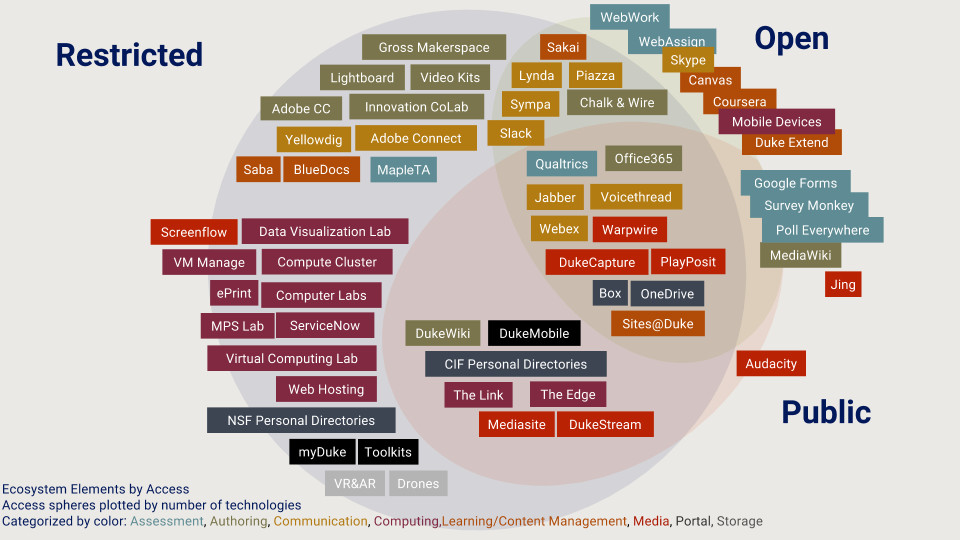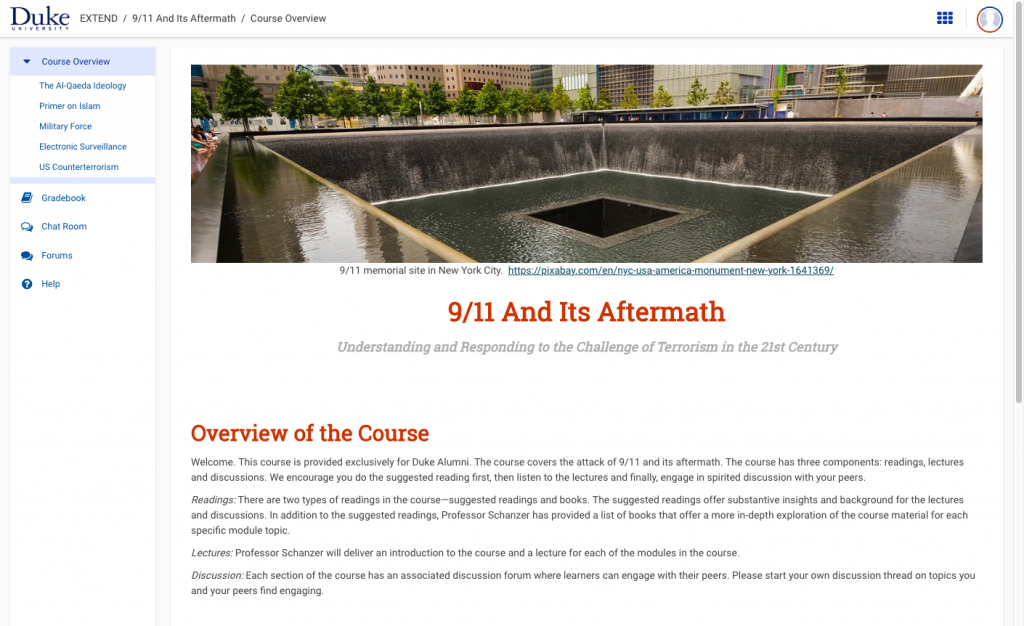TLDR;
- Duke Learning Innovation is shutting down its Open edX service.
- Duke Extend (what we previously called our Open edX service) is still offered to the Duke community by Learning Innovation and Duke’s Office of Information Technology (OIT) through new technologies.
- Learning Innovation can help you create flexible learning experiences and offer them to Duke students, the broader community including alumni and prospective students, or learners around the globe.
In the beginning, well, in a beginning
Four years ago, when I was baby Blue Devil, my first task was to evaluate the landscape of teaching and learning tools currently in use by the Duke community.
The research led to the graphic below which depicts the tools in relation to who can access them, a defining theme at the time.
To no one’s surprise, the majority of campus “enterprise” technologies were and still are only available to those with a university credential (what we call a netID) and are in the Restricted section.
At the same time, several interesting things were happening around the university.
- Duke was bitten by the MOOC bug. Exploring open and massive learning opportunities for folks who weren’t matriculated students.
- Duke’s alumni association and identity management team were working on a solution to allow alumni to access university resources after graduation, called Onelink.
Faculty who worked with us on MOOCs began coming to us with ideas for “opening their course” beyond the roster. We saw a gap in our technology infrastructure between Sakai and Coursera and kicked off a few projects to discover what might best fit that gap.
We selected Open edX and offered it as a service called Duke Extend.
Adapting to a changing landscape
Over the past 18 months, our thinking on Duke Extend has shifted.
We’ve realized that Duke Extend is not a tool to fill in the gap between Sakai and Coursera, it’s a tool to help fill in the gap between the for-credit course and the MOOC.
That small difference in wording has dramatically affected how we think about Duke Extend. In addition, the landscape has continued to evolve:
- Coursera for Duke Gives Campus Community Free Access to 40+ Online Courses – Duke Learning Innovation
- Duke’s Onelink service became available to anyone, not just alumni
- A redesigned catalog at online.duke.edu offered a superior “shopping” experience to Open edX.
While the university still has a gap between the for-credit course and the MOOC, we now have better infrastructure in place to fill that gap and no longer need a dedicated technology platform.
We’re shutting down our Open edX servers.
All active Duke Extend courses have been moved into Sakai and we’re testing new designs built specifically for the Duke Extend audience.
For example, we assume that Duke Extend learners are only in one course at a time and may have long gaps between learning experiences versus a traditional LMS learner which is in several at once, each semester.
Therefore, Duke Extend learners have no need for the favorites bar and we’ve hidden it as you can see in the screenshot below.
The new look for Extend has a clean, streamlined design that will allow us to create a more guided learning experience for students.
Heather Hans, Learning Experience Designer
Some examples offered through the Innovation Co-Lab roots/ program are below. While aimed at Duke students and staff, they are available to anyone with a Onelink:
If we discover changes that would prove valuable to the entire Duke Community, we’ll deploy those across all of Duke Sakai.
Duke Extend lives on, on multiple technology platforms
By using the online.duke.edu catalog as our communication and marketing platform, we are now free to choose the most appropriate technology for delivering a Duke Extend learning experience.
If you don’t need the assessment features and just want to share your content with a wider audience, why not use a content management system like WordPress or Drupal?
If you want a highly adaptive experience, why not use an adaptive learning platform?
If you want highly engaged discussion, why not use Slack or Microsoft Teams?
All of these tools can be branded as Duke Extend, integrated with other learning technologies, and listed in the online.duke.edu catalog. We are very excited about the possibilities this change opens up for Learning Innovation and our partners.
One more thing
This shift also connects to our broader strategy for Duke. We want to help Duke students learn more, and enable more people to learn from Duke.
We want to help high schoolers before they get to Duke, offer any current student the ability to level up with co-curricular learning, help graduate and professional schools expand their online education, and serve alumni in their lifelong learning needs.
As a department, we’ve rebranded and restructured ourselves to help achieve those goals. We also need technology infrastructure to facilitate them.
We’re partnering with Duke OIT and rolling out a service called Kits, which will offer a home for all types of learning experiences a learner might encounter at Duke, regardless of the technologies chosen for that learning experience …but that’s a story for another day. Stay tuned.
Happy New Year everyone!




